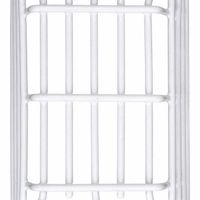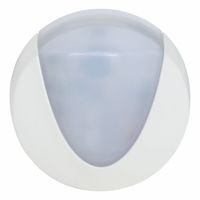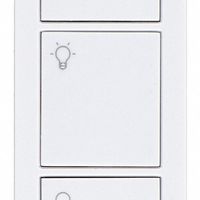Call +(254) 703 030 000 / 751 483 999 / 721 704 777
- Home
- Lighting
- Lighting Controls
- Lighting Control Accessories
.....Read More
Frequently Asked Questions
What are companion switches and how do they work?
Companion switches, also known as auxiliary or remote switches, are devices used in multi-location lighting control systems to allow control of a single light or group of lights from multiple locations. They are typically used in conjunction with a master switch, which directly controls the lighting load.
In a typical setup, the master switch is connected to the power source and the lighting fixture. The companion switches are installed at other locations where control is desired, such as at the top and bottom of a staircase or at opposite ends of a hallway. These switches communicate with the master switch to control the lighting.
Companion switches do not directly control the electrical load. Instead, they send signals to the master switch, which then adjusts the lighting accordingly. This communication can be wired or wireless, depending on the system design. In wired systems, traveler wires are used to connect the companion switches to the master switch. In wireless systems, radio frequency (RF) or other wireless communication technologies are used.
The operation of companion switches is seamless to the user. Pressing a companion switch sends a signal to the master switch, which then turns the lights on or off, or adjusts the dimming level if dimmable lights are used. This allows for convenient control of lighting from multiple locations without the need for complex wiring or multiple load-bearing switches.
Companion switches are commonly used in residential and commercial settings to enhance convenience and accessibility, providing flexible lighting control solutions in spaces where multiple access points are needed.
How do wireless remote controls integrate with lighting systems?
Wireless remote controls integrate with lighting systems through several key technologies and components. Primarily, they use radio frequency (RF), infrared (IR), Bluetooth, or Wi-Fi to communicate with lighting fixtures or a central hub.
1. **Radio Frequency (RF):** RF remote controls operate by sending signals via radio waves to a receiver integrated into the lighting system. These signals are typically in the 433 MHz or 2.4 GHz bands. RF is advantageous because it does not require a direct line of sight, allowing control from different rooms or through walls.
2. **Infrared (IR):** IR remotes use light signals in the infrared spectrum to communicate with a receiver on the lighting fixture. This method requires a direct line of sight and is commonly used in simple, short-range applications.
3. **Bluetooth:** Bluetooth-enabled remotes pair with lighting systems that have Bluetooth receivers. This technology allows for direct control and can also facilitate integration with smartphone apps for more advanced features like scheduling and scene setting.
4. **Wi-Fi:** Wi-Fi-based systems connect lighting fixtures to a home network, allowing remote controls to operate lights via the internet. This setup often involves a smart hub or bridge that translates Wi-Fi signals into commands for the lighting system. It enables control from anywhere with internet access, often through a smartphone app.
5. **Smart Hubs and Protocols:** Many modern systems use smart hubs that support multiple protocols like Zigbee or Z-Wave. These hubs act as intermediaries, translating signals from the remote control into commands that the lighting system can understand.
Overall, the integration of wireless remote controls with lighting systems enhances convenience, allowing users to adjust lighting conditions effortlessly and often from a distance or even remotely via the internet.
What is the purpose of power and relay control units in lighting systems?
Power and relay control units in lighting systems serve several critical functions to enhance efficiency, flexibility, and control. These units are integral in managing the distribution and regulation of electrical power to lighting fixtures, ensuring that lights operate optimally and safely.
1. **Power Management**: They regulate the flow of electricity to lighting systems, ensuring that the correct voltage and current are supplied. This prevents overloading and potential damage to lighting fixtures, thereby extending their lifespan.
2. **Automation and Control**: Relay control units enable automation of lighting systems. They can be programmed to turn lights on or off at specific times or in response to certain conditions, such as occupancy or ambient light levels. This automation enhances energy efficiency by reducing unnecessary power consumption.
3. **Remote Operation**: These units allow for remote control of lighting systems, often through integration with building management systems or smart home technologies. This capability provides convenience and flexibility, allowing users to adjust lighting settings from a distance.
4. **Load Switching**: Relays are used to switch electrical loads on and off. They can handle high power loads with low power control signals, making them ideal for controlling large lighting systems without the need for heavy-duty switches.
5. **Safety and Protection**: Power and relay control units offer protection features such as circuit breakers and surge protection. These features safeguard the lighting system against electrical faults, reducing the risk of fire and equipment damage.
6. **Customization and Zoning**: They allow for the creation of lighting zones, where different areas can be controlled independently. This zoning capability supports customized lighting environments tailored to specific needs or activities.
Overall, power and relay control units are essential for optimizing the performance, safety, and energy efficiency of lighting systems.
How do occupancy sensor photocells function in lighting control?
Occupancy sensor photocells function in lighting control by detecting the presence or absence of people in a space and adjusting the lighting accordingly. These sensors typically use infrared, ultrasonic, or microwave technology to sense motion or body heat. When a person enters a room, the sensor detects the change and sends a signal to the lighting control system to turn the lights on. If no motion is detected for a predetermined period, the sensor assumes the space is unoccupied and signals the system to turn the lights off, conserving energy.
Photocells, on the other hand, are light-sensitive components that measure ambient light levels. They are often used in conjunction with occupancy sensors to ensure that lights are only activated when necessary. For instance, if natural daylight is sufficient, the photocell can prevent the lights from turning on, even if the occupancy sensor detects movement. This dual functionality optimizes energy efficiency by ensuring that artificial lighting is used only when needed.
Together, occupancy sensors and photocells provide a smart lighting control solution that enhances energy savings and convenience. They are commonly used in commercial buildings, offices, and public spaces where lighting needs fluctuate based on occupancy and natural light availability. By automating lighting control, these sensors reduce energy consumption, lower utility costs, and contribute to sustainability efforts.
What are the benefits of using mounting accessories for lighting systems?
Mounting accessories for lighting systems offer several benefits that enhance both functionality and aesthetics. Firstly, they provide flexibility in installation, allowing lights to be positioned at optimal angles and heights to achieve desired illumination levels. This adaptability ensures that lighting can be tailored to specific tasks or environments, improving visibility and reducing glare.
Secondly, mounting accessories contribute to the safety and stability of lighting systems. They secure fixtures in place, minimizing the risk of accidents or damage due to vibrations or external forces. This is particularly important in industrial or outdoor settings where environmental factors can affect the integrity of lighting installations.
Additionally, these accessories can enhance the aesthetic appeal of lighting systems. They come in various designs and finishes, allowing for seamless integration with architectural elements and interior decor. This can elevate the overall look of a space, making it more inviting and cohesive.
Mounting accessories also facilitate easier maintenance and upgrades. By providing straightforward access to lighting fixtures, they simplify the process of replacing bulbs or making adjustments, thereby reducing downtime and maintenance costs.
Moreover, they can improve energy efficiency. By enabling precise positioning of lights, mounting accessories help direct light exactly where it is needed, reducing wastage and ensuring that energy is used effectively.
Finally, they offer versatility in lighting design. With a range of options such as track systems, brackets, and adjustable arms, mounting accessories allow for creative lighting solutions that can be customized to meet specific needs and preferences.
In summary, mounting accessories for lighting systems enhance functionality, safety, aesthetics, maintenance, energy efficiency, and design versatility, making them a valuable component in both residential and commercial lighting applications.
How do you install and configure a lighting control system?
To install and configure a lighting control system, follow these steps:
1. **Plan and Design**: Assess the lighting needs and layout of the space. Determine the type of control system (wired or wireless) and the components required, such as dimmers, sensors, and control panels.
2. **Select Components**: Choose compatible components from the same manufacturer to ensure seamless integration. Common components include smart switches, dimmers, motion sensors, and a central control hub.
3. **Install Wiring**: For wired systems, run the necessary electrical wiring according to the design plan. Ensure compliance with local electrical codes and safety standards. For wireless systems, ensure a strong and reliable network connection.
4. **Install Devices**: Mount switches, dimmers, and sensors in their designated locations. Follow the manufacturer's instructions for installation, ensuring all connections are secure.
5. **Connect to Power**: Safely connect the system to the power supply. Double-check all connections to prevent short circuits or electrical hazards.
6. **Configure the System**: Use the control hub or app to configure the system. Set up zones, scenes, and schedules according to user preferences. Assign devices to specific areas and customize settings for each.
7. **Test the System**: Verify that all components are functioning correctly. Test different scenes and schedules to ensure the system operates as intended. Adjust settings as necessary for optimal performance.
8. **User Training**: Educate users on how to operate the system, including manual controls and app-based management. Provide guidance on troubleshooting common issues.
9. **Maintenance**: Schedule regular maintenance checks to ensure the system remains in good working condition. Update software and firmware as needed to enhance functionality and security.
What are the advantages of using a lighting control system in a building?
A lighting control system in a building offers numerous advantages, enhancing both functionality and efficiency. Firstly, it significantly improves energy efficiency by allowing precise control over lighting levels, reducing unnecessary energy consumption. This can lead to substantial cost savings on electricity bills. Secondly, it provides enhanced convenience and flexibility, enabling users to adjust lighting settings remotely or automatically based on occupancy, time of day, or natural light availability. This adaptability can create optimal lighting conditions for various activities and preferences.
Additionally, lighting control systems contribute to increased comfort and productivity. By adjusting lighting to suit specific tasks or moods, they can enhance the well-being and performance of occupants. For instance, dimming lights during presentations or increasing brightness for detailed work can improve focus and reduce eye strain.
Moreover, these systems offer improved security and safety. Automated lighting can deter intruders by simulating occupancy, and motion sensors can illuminate pathways, reducing the risk of accidents. Integration with other building systems, such as HVAC and security, further enhances overall building management and efficiency.
Lighting control systems also support sustainability goals by reducing carbon footprints and promoting environmentally friendly practices. They can be integrated with renewable energy sources, such as solar panels, to optimize energy use.
Finally, they offer scalability and future-proofing, allowing for easy upgrades and integration with emerging technologies. This ensures that buildings remain adaptable to changing needs and technological advancements.
In summary, a lighting control system enhances energy efficiency, convenience, comfort, security, sustainability, and adaptability, making it a valuable investment for modern buildings.




